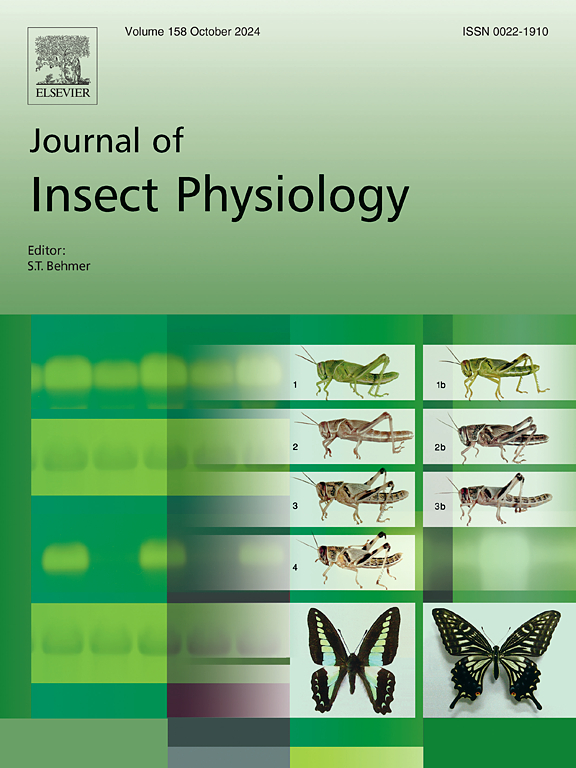白衣原甲(鞘翅目:金盏花总科)中三种触角特异性气味结合蛋白参与了花挥发物的识别。
IF 2.3
2区 农林科学
Q1 ENTOMOLOGY
引用次数: 0
摘要
气味结合蛋白(OBPs)在昆虫嗅觉识别系统中起着至关重要的作用,因为它们结合并运输特定的化学物质到化学感觉受体进行进一步处理。农业和园艺害虫白斑花黄斑病(WSFC),白斑花黄斑病(Protaetia brevitarsis)(鞘翅目,金甲总科)严重危害着中国的许多作物和水果。据推测,WSFCs依赖于特定的obp和化学感觉受体来识别美味的食物来源和最佳的产卵地点。在我们的研究中,从WSFC基因组中鉴定出23个推定OBPs (PbreOBPs)。系统发育分析表明,PbreOBPs与Holotrichia parallela和anomalala corpulenta具有高度的相似性。组织表达谱显示,10个PbreOBPs表现出天线偏倚表达。我们重组并纯化了三种天线特异性PbreOBPs: PbreOBP8、PbreOBP9和PbreOBP18。荧光竞争结合分析显示,它们对β-离子酮、水杨酸苯乙酯、苯乙醛和苯甲酸苄酯具有较高的结合亲和力,这些化合物通常存在于花挥发物中。此外,PbreOBP8显示出结合微生物挥发物的能力,如3-辛醇、3-甲基-1-丁醇和1-辛醇-3-醇,这表明它在寻找食物或产卵地点方面发挥了作用。此外,我们还预测了3种PbreOBPs与植物和微生物挥发物结合的关键酸残基。本研究表明,触角特异性基因PbreOBP8、PbreOBP9和PbreOBP18可能参与介导花挥发物的识别。这些发现为进一步研究PbreOBPs提供了可能的途径,并为WSFC种群建立基于嗅觉的控制方法提供了潜在的目标。本文章由计算机程序翻译,如有差异,请以英文原文为准。

Three antenna-specific odorant binding proteins in Protaetia brevitarsis (Coleoptera: Scarabaeoidea) involve in recognition of floral volatiles
Odorant binding proteins (OBPs) play a vital role in the insect olfactory recognition system, as they bind and transport specific semiochemicals to chemosensory receptors for further processing. The agricultural and horticultural pest, white-spotted flower chafer (WSFC), Protaetia brevitarsis (Coleoptera, Scarabaeoidea), has significantly harmed numerous crops and fruits in China. It is hypothesized that WSFCs rely on specific OBPs and chemosensory receptors to identify palatable food sources and optimal oviposition sites. Twenty-three putative OBPs (PbreOBPs) were identified from the WSFC genome in our research. Based on phylogenetic analysis, PbreOBPs exhibited high degree of similarity to those of Holotrichia parallela and Anomala corpulenta. Tissue expression profiles showed that ten PbreOBPs exhibited antenna-biased expression. We recombined and purified three antenna-specific PbreOBPs: PbreOBP8, PbreOBP9, and PbreOBP18. Fluorescence competitive binding assays revealed that they had higher binding affinities to β-ionone, phenethyl salicylate, phenylacetaldehyde, and benzyl benzoate — compounds commonly found in floral volatiles. Additionally, PbreOBP8 showed the ability to bind microbial volatiles, such as 3-octanol, 3-methyl-1-butanol, and 1-octen-3-ol, suggesting a role in locating food or oviposition sites. Forthermore, we also predicted the key acid residues which involved in the binding of three PbreOBPs towards floral and microbial volatiles. The present investigation demonstrated that the antenna-specific PbreOBP8, PbreOBP9 and PbreOBP18 were likely involved in mediating the recognition of floral volatiles. The findings introduce possible avenues for further research into PbreOBPs and provide potential targets for creating olfactory-based control methods for WSFC populations.
求助全文
通过发布文献求助,成功后即可免费获取论文全文。
去求助
来源期刊

Journal of insect physiology
生物-昆虫学
CiteScore
4.50
自引率
4.50%
发文量
77
审稿时长
57 days
期刊介绍:
All aspects of insect physiology are published in this journal which will also accept papers on the physiology of other arthropods, if the referees consider the work to be of general interest. The coverage includes endocrinology (in relation to moulting, reproduction and metabolism), pheromones, neurobiology (cellular, integrative and developmental), physiological pharmacology, nutrition (food selection, digestion and absorption), homeostasis, excretion, reproduction and behaviour. Papers covering functional genomics and molecular approaches to physiological problems will also be included. Communications on structure and applied entomology can be published if the subject matter has an explicit bearing on the physiology of arthropods. Review articles and novel method papers are also welcomed.
 求助内容:
求助内容: 应助结果提醒方式:
应助结果提醒方式:


